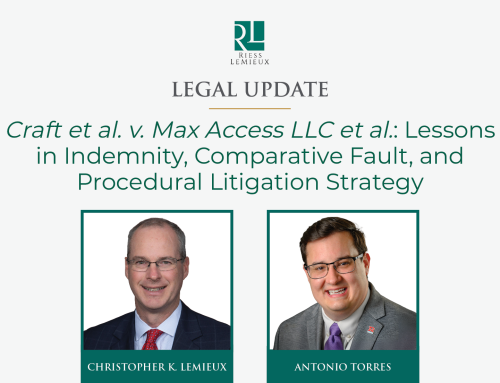 Authors: Christopher K. LeMieux and Hannah Marler
Authors: Christopher K. LeMieux and Hannah Marler
A Cautionary Tale: CGL Exclusion for Wrap Up Projects Leaves Subcontractor Who Fails to Properly Enroll in CCIP without Insurance Coverage.
A recent Fourth Circuit decision is a stark reminder about conflicts in coverage and a reason to ensure that insurance enrollment is properly handled. In Soule v. Woodward Design + Build, LLC et al., the Fourth Circuit recently considered whether a “Wrap Up” exclusion in a subcontractor’s commercial general liability (“CGL”) policy was applicable even when that subcontractor was not enrolled in the general contractor’s Contractor Controlled Insurance Program (“CCIP”). In Soule, Woodward Design + Build, LLC (“Woodward”) served as the general contractor on the project. The contract between Woodward and the owner required Woodward to obtain a CCIP or “Wrap Up” coverage, which was purchased. Woodward entered into a subcontract with Eagle Access, LLC (“Eagle”), which stated that Woodward would arrange for the project to be insured under a CCIP and that the CCIP provided CGL coverage for performance of work on the project. In order to be covered by Woodward’s CCIP, Eagle was required to enroll in the program. Eagle instead elected to get its own coverage.
Eagle separately purchased its own CGL insurance through TBIC. Eagle’s insurance policy with TBIC contained an exclusion, referred to as the “Wrap Up Exclusion”, that excluded coverage in “[a]ll locations where you perform or have performed work that is or was to be insured under a consolidated (wrap-up) insurance program as described below.” The Louisiana Supreme Court, in a separate, subsequent case, ruled that Eagle was not insured under Woodward’s CCIP because it failed to follow proper enrollment procedures.
Eventually, the plaintiff sued Woodward, Eagle, and the respective insurers after being injured on the project site by an elevator lift installed by Eagle. Subsequently, a dispute arose between Woodward, Eagle, and their insurers as to which insurer provided coverage for the work performed by Eagle. The question before the Fourth Circuit was whether Eagle was required to be enrolled in Woodward’s CCIP for the TBIC Wrap Up exclusion to apply. Plaintiffs in the case argued that the Wrap Up Exclusion should only apply when the insured is actually enrolled in the Wrap Up program not just when the insured is eligible to enroll in the Wrap Up program.
The Fourth Circuit considered the specific language of the TBIC policy in strict compliance with Louisiana’s well-established principles for interpreting insurance policies. The TBIC policy stated that coverage for Eagle is excluded in “[a]ll locations where you perform or have performed work that is or was to be insured under a consolidated (wrap-up) insurance program …” However, the TBIC policy does not require that the exclusion only applies if Eagle was actually enrolled in the CCIP policy. Thus, the Court held that the TBIC Wrap Up exclusion applied even if Eagle was not enrolled in Woodward’s CCIP.
This ruling by the Louisiana Fourth Circuit presents a dangerous situation for subcontractors on projects where the general contractor implements a CCIP. The failure to properly enroll may leave contractors without any insurance coverage at all if an injury or other issue arises on the project. The failure to secure proper coverage could result in costly awards for damages being paid directly by the contractor instead of an insurer. Further, it is not a far cry to extrapolate this decision to a scenario where an Owner Controlled Insurance Program (“OCIP”) is implemented, creating a larger range of exposure for general contractors as well. Overall, Soule is a stark reminder to pay attention to the deadlines and requirements for CCIP enrollment.



